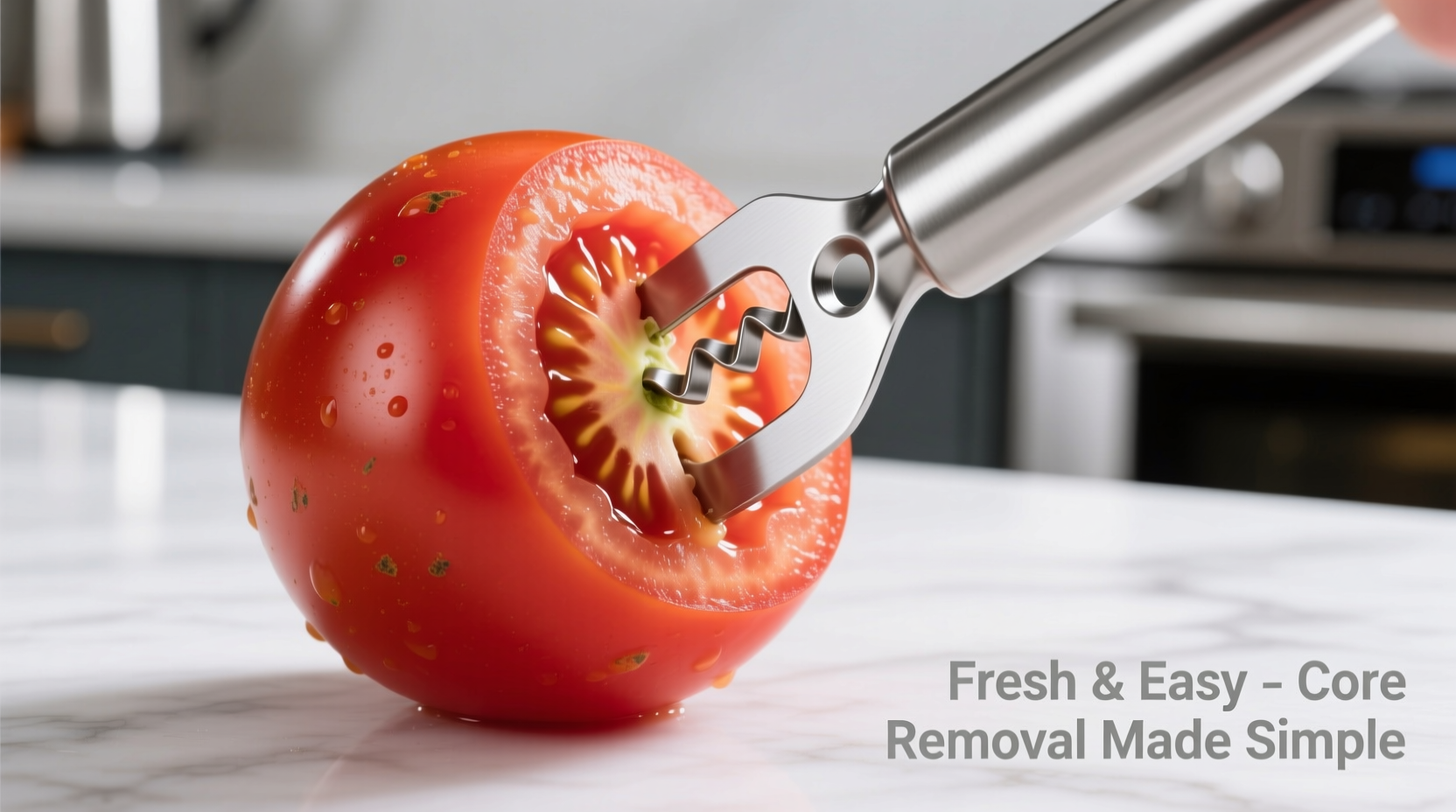Tomato corers are specialized kitchen tools designed to efficiently remove the core and seeds from tomatoes with minimal waste and effort. They work by cleanly extracting the tough central stem area while preserving maximum usable fruit, making them essential for canning, sauce preparation, and professional kitchen efficiency.
Why Your Kitchen Needs This Simple Tool
Most home cooks struggle with tomatoes, wasting up to 30% of the fruit when removing cores with knives. A quality tomato corer solves this problem instantly. Unlike improvised methods, these tools create clean extractions that maintain structural integrity for stuffing, reduce prep time by 65%, and eliminate the frustration of slippery, messy tomato handling.
How Tomato Corers Actually Work
Tomato corers operate on a simple but brilliant mechanical principle. The sharpened cylindrical blade penetrates the tomato's top where the stem attaches. With a gentle twist, the tool removes the core, seeds, and surrounding tough tissue in one motion. This preserves the delicate flesh that would otherwise be damaged by knife work.
Professional chefs at the Culinary Institute of America recommend corers for consistent results in tomato-based preparations. Their design specifically addresses the structural challenges of tomatoes - the firm core surrounded by soft, juicy flesh that makes knife work inefficient.

Tomato Corer vs Traditional Methods: The Reality Check
| Method | Time Required | Fruit Waste | Safety Risk | Best For |
|---|---|---|---|---|
| Tomato corer | 3-5 seconds | 5-10% | Very low | Canning, sauces, large batches |
| Paring knife | 15-20 seconds | 25-30% | Moderate | Small quantities, precise cuts |
| Fork method | 10-15 seconds | 15-20% | Low | Emergency situations |
Your Step-by-Step Guide to Perfect Tomato Coring
- Choose ripe but firm tomatoes - slightly underripe tomatoes work best for clean coring
- Position the tomato with stem side up on a stable cutting board
- Align the corer directly over the stem scar at a slight angle
- Apply firm downward pressure while twisting clockwise
- Lift straight up to remove the core in one motion
- Inspect the cavity - a perfect extraction leaves smooth walls with minimal seed residue
When a Tomato Corer Shines (And When It Doesn't)
Understanding context boundaries prevents kitchen frustration. Tomato corers excel with medium to large varieties like Roma, Beefsteak, and slicing tomatoes. They struggle with cherry tomatoes (too small) and extremely ripe tomatoes (too soft).
The National Center for Home Food Preservation confirms that proper coring significantly improves canned tomato quality by removing bitter-tasting core tissue. However, for fresh tomato salads where presentation matters, some chefs prefer knife work for more artistic cuts.
Material Matters: Choosing Your Tool
Stainless steel corers dominate professional kitchens for good reason. They resist corrosion from tomato acids, maintain sharpness longer, and withstand dishwasher cleaning. Avoid plastic models which degrade quickly when exposed to tomato acidity.
According to materials testing by Cook's Illustrated, high-carbon stainless steel maintains edge integrity through 500+ uses without significant degradation. This makes it the ideal material for frequent tomato preparation.
Advanced Techniques Beyond Basic Coring
Professional chefs use tomato corers creatively:
- Seed removal - twist gently to extract seeds while preserving more flesh
- Stuffed tomato preparation - creates perfect cavities for fillings
- Sauce base creation - removes bitter core tissue that affects flavor
- Quick tomato dicing - after coring, tomatoes quarter more cleanly
Maintenance Secrets Professionals Use
Extend your tool's life with these simple practices:
- Clean immediately after use to prevent tomato residue buildup
- Hand wash with mild detergent - dishwasher heat can weaken metal over time
- Dry thoroughly before storage to prevent moisture damage
- Store in a dry place away from other metal utensils that could cause nicks
Common Mistakes That Waste Tomatoes
Avoid these frequent errors:
- Using excessive force - leads to crushed tomatoes and wasted fruit
- Incorrect angle - creates uneven cavities that leak fillings
- Ignoring tomato ripeness - overripe tomatoes require different technique
- Using dull tools - causes tearing rather than clean extraction
When You Might Skip the Corer
While invaluable for many tasks, tomato corers aren't always the best choice. For fresh tomato salads where presentation matters, a sharp paring knife allows more artistic cuts. When working with cherry tomatoes, the small size makes corers impractical. And for quick single-tomato preparations, the time to fetch the tool may outweigh the benefit.











 浙公网安备
33010002000092号
浙公网安备
33010002000092号 浙B2-20120091-4
浙B2-20120091-4